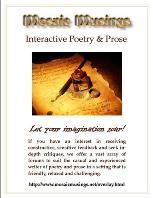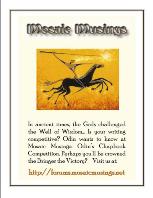 Aug 8 03, 18:29 Aug 8 03, 18:29
Post
#1
|
|
|
Group: Administrator Posts: 18,892 Joined: 1-August 03 From: Massachusetts Member No.: 2 Real Name: Lori Kanter Writer of: Poetry & Prose Referred By:Imhotep |
Figurative Language
Similes explicitly compare items from different classes using a connective such as “like”, “as”, or “than”, or by a verb such as “appears” or “seems”. The catch here is in the object being compared. If the objects are in the same class, as in this phrase, “New York is like London” there is no simile. Sometimes I feel like a motherless child. ~Anonymous It is a beauteous evening, calm and free. The holy time is quiet as a nun, Breathless with adoration. ~Wordsworth How sharper than a serpent’s tooth it is to have a thankless child. ~Shakespeare Metaphor asserts the identity (an implied comparison), without a connective such as “like” or a verb such as “appears”, of the terms that are literally incomparable. Metaphor uses mechanisms outside the realm of everyday conventional language. She is the rose, the glory of the day. ~Spenser O western orb sailing the heaven. ~Whitman ‘Orb’ is the stated word above, when matched with ‘sailing’ however, a ‘ship’ is implied in ‘sailing’. Personification asserts an attribution of human characteristics or feelings to an inanimate object (something nonhuman) or abstraction; a subtype of metaphor in which the figurative term is always a human being. But Time did beckon to the flowers, and they by noon most cunningly did steal away. ~Herbert Hope, thou bold taster of delight. ~Crashaw Apostrophe addresses someone absent or something nonhuman as if it were alive or present and could respond. Tyger, Tyger, burning bright ~Blake Hail to thee, blithe Spirit! ~Shelley Imagery is a representation in words of a sensory experience; words which appeal to one or more of the senses; a visual image or mental picture. The goat-footed balloonMan whistles" ~Cummings Two roads diverged in a yellow wood ~Frost Symbolism is a specific idea or object that may stand for ideas, values, persons or ways of life; something that means more than what it is. O Rose, thou art sick. The invisible worm that flies in the night in the howling storm has found out thy bed of crimson joy, and his dark secret love does thy life destroy. ~Blake Verbal Irony is when one says the opposite of what is actually meant. The grave’s a fine and private place, but none, I think, do there embrace. ~Marvell Paradox is an apparent contradiction, which is actually true. The child is father of the man. ~Wordsworth The saviors come not home tonight; themselves they could not save. ~Housman Alliteration is the deliberate repetition of consonant sounds, i.e. the Weeping willow whispered.... Assonance is the deliberate repetition of identical or similar vowel sounds, i.e. Boo flew to a new pool. Diction is the poet's distinctive choices in vocabulary. Echo is the repetition of a key word or idea for effect. Hyperbole is an exaggeration for dramatic effect. Onomatopoeia is "sound echoing sense"; the use of words resembling the sounds they mean. For example, in “Song of the Lotus-Eaters” Tennyson indicates the slow, sensuous, and langorous life of the Lotus-Eaters by the sound of the words he uses to describe the land in which they live: Here are cool mosses deep, And through the moss the ivies creep, And in the stream the long-leaved flowers weep, And from the craggy ledge the poppy hangs in sleep. Oxymoron is a seeming contradiction in two words put together, i.e. Jumbo Shrimp, Thunderous Silence. Rhyme a repetition of the same sounds, i.e. fog, dog. Rhythm is the internal 'feel' of a beat and meter perceived when poetry is read aloud. Tone, Mood are feelings or meanings conveyed in the poem. ·······  ······· ·······"It's a dangerous business, Frodo, going out your door. You step into the Road, and if you don't keep your feet, there is no knowing where you might be swept off to." ~ J.R.R Tolkien, The Lord of the Rings
Collaboration feeds innovation. In the spirit of workshopping, please revisit those threads you've critiqued to see if the author has incorporated your ideas, or requests further feedback from you. In addition, reciprocate with those who've responded to you in kind. "I believe it is the act of remembrance, long after our bones have turned to dust, to be the true essence of an afterlife." ~ Lorraine M. Kanter Nominate a poem for the InterBoard Poetry Competition by taking into careful consideration those poems you feel would best represent Mosaic Musings. For details, click into the IBPC nomination forum. Did that poem just captivate you? Nominate it for the Faery award today! If perfection of form allured your muse, propose the Crown Jewels award. For more information, click here!  "Worry looks around, Sorry looks back, Faith looks up." ~ Early detection can save your life. "Worry looks around, Sorry looks back, Faith looks up." ~ Early detection can save your life.MM Award Winner  |
|
|
|
 |
Replies
| Guest_Martinus Julius Caesura_* |
 Aug 31 03, 21:31 Aug 31 03, 21:31
Post
#2
|
|
|
QUOTE TERMS: Rhythm goes well beyond accented and unaccented syllables. Rhythm is any wave-like recurrence (pattern) of sound.
QUOTE
QUOTE
(1) Stress-Syllabic meter (also called Syllable-Stress meter, or Accentual-Syllabic meter) is defined in terms of both the number and the arrangement of accented (stressed) and unaccented (unstressed) syllables (measured by “accentual feet”) in a line. (2) Stress-meter (also called Strong-Stress meter, Accentual-Stress meter, or Alliterative-Stress meter) is defined in terms of only the number of stressed syllables in a line. (3) Syllabic meter is defined in terms of only the number of syllables per line, without regard to stresses. (4) Quantitative meter is defined in terms of durational rather than accentual feet—i.e., each foot consists of “long” and “short,” rather than “stressed” and “unstressed,” syllables. Most of the metered poems written today are in stress-syllabic meter (#1, above). QUOTE
With that change, all of the above apply to stress-syllabic meter. And there are many more kinds of feet in such meter, but there are only eight that seem to be commonly used—the above three, plus the following five: Dactyl - Consists of a stressed syllable followed by two unstressed syllables, as in dinosaur. Spondee - Consists of two stressed syllables, as in spice rack. Pyrric - Consists of two unstressed syllables, as in and a. Amphimacer - Consists of a stressed syllable followed by an unstressed syllable, followed by a stressed syllable, as in amazon. Amphibrachys - Consists of an unstressed syllable, followed by a stressed syllable, followed by an unstressed syllable, as in amoeba. -Martin |
|
|
|
Posts in this topic
 Cleo_Serapis Figurative Language - Poetic Devices Aug 8 03, 18:29
Cleo_Serapis Figurative Language - Poetic Devices Aug 8 03, 18:29 
 Cleo_Serapis WRITING POETRY: Write of an experience of your own... Aug 20 03, 19:46
Cleo_Serapis WRITING POETRY: Write of an experience of your own... Aug 20 03, 19:46 
 Don I wish to thank Lori for starting critical thought... Nov 28 03, 10:08
Don I wish to thank Lori for starting critical thought... Nov 28 03, 10:08 1 User(s) are reading this topic (1 Guests and 0 Anonymous Users)
0 Members:
  |

|
Lo-Fi Version | Time is now: 3rd September 2025 - 03:59 |

















